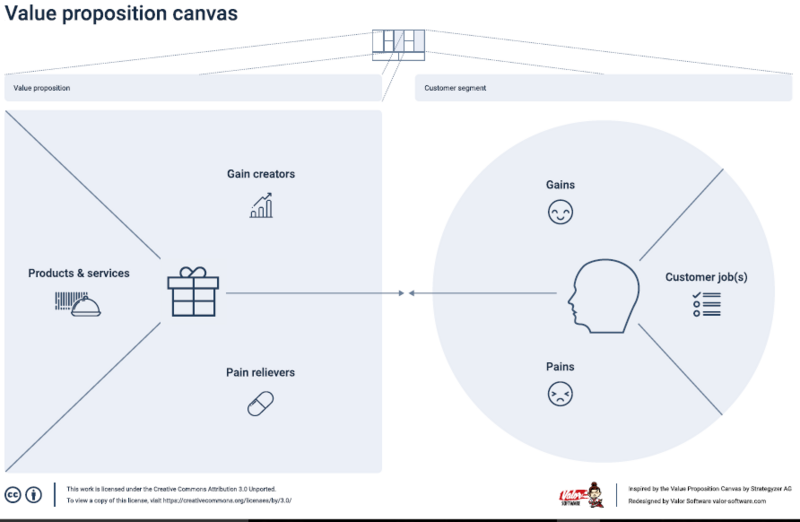Value Proposition Canvas
(→Application) |
(→Application) |
||
| Line 25: | Line 25: | ||
''Pains:'' The pains tell which negative effects the user is experiencing for status quo. This can be a result of competitors lacking the necessary capabilities to offer a proper product or service. It can also be a result of users not having access to any products or services to fulfil their customer job. The project manager must acknowledge these customer pains, in order to identify the benefits a project outcome needs to incorporate. | ''Pains:'' The pains tell which negative effects the user is experiencing for status quo. This can be a result of competitors lacking the necessary capabilities to offer a proper product or service. It can also be a result of users not having access to any products or services to fulfil their customer job. The project manager must acknowledge these customer pains, in order to identify the benefits a project outcome needs to incorporate. | ||
| − | ''Gains:'' | + | ''Gains:'' Unlike pains, gains are not factors which are clear for the user. These are factors that the user is not necessarily expecting of a product or service, but are extra benefits supplied. Gains are not essential for project success, but rather an area where project managers can differentiate their project outcomes. In the Gambia case the gains delivered came in form of education in hygiene, local training of staff and clean toilet facilities. Instead of only providing clean drinking water, the consulting company provided extra features, which made them differentiate themselves in the highly competitive market of consultancy. |
| − | '''Value proposition:''' | + | '''Value proposition:''' Going from the customer segment side to the value proposition the focus changes from what to how; how will the project deliverables satisfy customer needs? |
''Products & services:'' | ''Products & services:'' | ||
| − | ''Pain relievers:'' | + | ''Pain relievers:'' Pain relievers are ways of removing the customer/user’s pains. These deliverables are essential for user satisfaction. |
''Gain Creators:'' | ''Gain Creators:'' | ||
Revision as of 09:31, 17 February 2018
Contents |
Abstract
An important aspect of project management is stakeholder management which contains many different tools and theories. An essential part of this management is the alignment of stakeholder expectations with project deliverables. The reason for a project initiation is a business case. These business cases are based on needs from stakeholders such as customers/users. Users are the persons or organizations who will use the project's product, service, or result.[1] To make sure the project is a success the needs of users must be thoroughly understood. As an example a consulting company can have the government as a client on a project, but the users of the project outcome are the citizens. No matter how succesful the government finds the project, it can all go to waste if the users are not satisfied. A tool for analysing these needs is the Value Proposition Canvas. The canvas assesses two different aspects:
1. The internal organizational side containing which products and services the organization will provide to the user.
2. The external user side which represents the user needs in form of pains of status quo and gains of project success.
The project manager can use the tool to analyse and connect these two aspects to make sure that all needs of users are satisfied as well as being differentiated by bringing gain creators to the users.
Big idea & Project manager relation
Since the expectations of stakeholder groups will differ, it is not unusual for conflict to exist regarding the importance or desirability of aspects of strategy. [2]
Application
[3] Customer segment:
Customer job(s): The customer job(s) asses what the customer want to do, which actions or tasks does the customer or user want to perform. In the Gambia case the users have a very basic customer job in the accessibility of clean drinking water.
Pains: The pains tell which negative effects the user is experiencing for status quo. This can be a result of competitors lacking the necessary capabilities to offer a proper product or service. It can also be a result of users not having access to any products or services to fulfil their customer job. The project manager must acknowledge these customer pains, in order to identify the benefits a project outcome needs to incorporate.
Gains: Unlike pains, gains are not factors which are clear for the user. These are factors that the user is not necessarily expecting of a product or service, but are extra benefits supplied. Gains are not essential for project success, but rather an area where project managers can differentiate their project outcomes. In the Gambia case the gains delivered came in form of education in hygiene, local training of staff and clean toilet facilities. Instead of only providing clean drinking water, the consulting company provided extra features, which made them differentiate themselves in the highly competitive market of consultancy.
Value proposition: Going from the customer segment side to the value proposition the focus changes from what to how; how will the project deliverables satisfy customer needs?
Products & services:
Pain relievers: Pain relievers are ways of removing the customer/user’s pains. These deliverables are essential for user satisfaction.
Gain Creators:
Limitations
1. Not looking at the Value Proposition Canvas as two separate building blocks:
2. Mixing several customer segments into one canvas:
3. Creating your Customer Profile through the lens of your value proposition:
4. Only focusing on functional jobs:
5. Trying to address every customer pain and gain:
6. Difficulty of data collection:
Annotated bibliography
References
- ↑ Project Management Institute, A Guide to the Project Management Body of Knowledge (PMBOK® Guide), Fifth Edition, 2013
- ↑ Johnson, Gerry. (2015) Fundamentals of Strategy, Third Edition
- ↑ den Ouden, E. (2012) Innovation Design. Springer
- ↑ http://blog.strategyzer.com/posts/2015/2/19/5-common-mistakes-to-avoid-when-using-the-value-proposition-canvas
